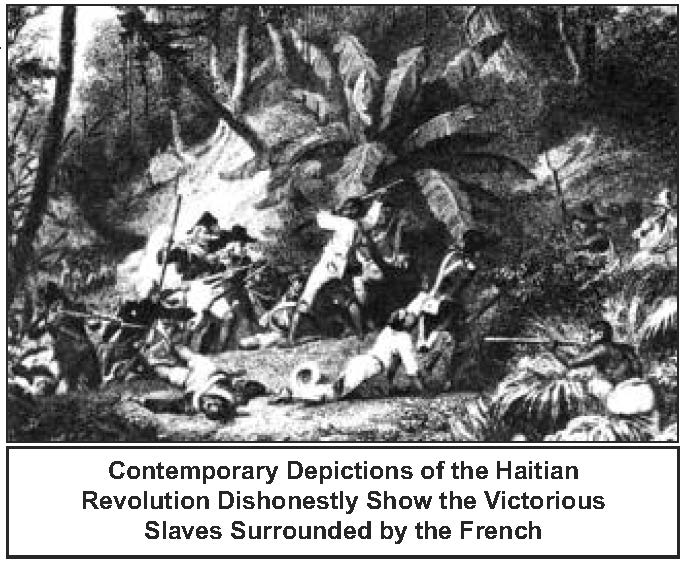This is not a book review. It does,
however, ask you to read The Making of
Haiti by Caroline Fick. This book could
be a start of collectively re-evaluating
the Haitian revolution as not just a successful
revolution against chattel slavery
and colonialism but also against the
mass institutions (the plantations) of
wage slavery. Perhaps the Haitian revolution
which also abolished night work
some 70 years before the Paris Commune
should be placed among the great
working-class revolutions of history.
 The book is an important starting
point because it makes the masses the
makers of history. It is the story of the
development of an heroic mass line. It
throws light on the field slaves' organizations,
ideological struggles, skills, development
and achievements. You are one-third
of the way through the book before there is even
mention of Toussaint L'Ouverture, the famous
general. He is mentioned then because as a free
black he could travel openly from one plantation
to another carrying news of upcoming, or accounts
of past, night-time secret meetings. Yet
even at that time Toussaint had his feet in both
camps, with connections to the French royalists
(not the French revolutionaries).
The book is an important starting
point because it makes the masses the
makers of history. It is the story of the
development of an heroic mass line. It
throws light on the field slaves' organizations,
ideological struggles, skills, development
and achievements. You are one-third
of the way through the book before there is even
mention of Toussaint L'Ouverture, the famous
general. He is mentioned then because as a free
black he could travel openly from one plantation
to another carrying news of upcoming, or accounts
of past, night-time secret meetings. Yet
even at that time Toussaint had his feet in both
camps, with connections to the French royalists
(not the French revolutionaries).
By any objective point of view, Haiti in the late
1790s was the most unlikely place to project a
successful revolution against slavery. Plantation
slavery was central to the worldwide development
of industrial capital. It provided super profits (a
slave ship could return a profit of 300% on one
voyage). It provided the new European industries
with cheap raw materials. It provided them markets
for their manufactured goods. It even developed
their banking system since the volume of
the trade, and the time it took to sail the circuit
from Europe to Africa to the Americas and back
to Europe, demanded the creation of a credit system
the likes of which had never been seen.
In all of this, Haitian plantations were the most
profitable in the world. Controlled by French
colonialism, they were coveted by both British
and Spanish imperialists. In short, the armed
might of three of the most powerful nations in the
world wanted slavery in Haiti. But Frick's book
doesn't spend much time on this "objective" situation.
Her book deals with the key "subjective"
factor – the slaves themselves.
The struggle against Haitian slavery is a
long, rich and complicated history, which
we won't go into here, except to highlight
three points which suggest that a study of
the revolution will help us today realize
key features in the development of a mass
revolutionary line.
First, in the late 1790s many of the
slaves bought from the Kongo were soldiers
who had been captured in a civil war.
Their military skills undoubtedly helped in
securing the first stunning victories of the
revolution. Military work is key.
Second, at a crucial point after the defeat
of the French, Haitian leaders like
Toussaint tried to re-impose the plantation
system, offering the workers a quarter of
the profits as wages. The ex-slaves refused.
The similarities between the work-discipline
rule of chattel slavery and wage slavery help
illustrate the deep connection between racism and
capitalism (a scenario that is playing out again
today in South Africa).
Third, the power of the mass line. Toward the
end it was Christophe, a black general who turned
and sided with the French, who finally assessed
the hopelessness of the French position. It was not
the military might of the revolutionaries that
would win the day. In fact he thought they could
be defeated. "The danger [to the French]," he
pointed out, "was in the general opinion of the
blacks." It was a concept Marx was to point out
years later: "Ideas, when grasped by the masses,
become a material force.
|

 The book is an important starting
point because it makes the masses the
makers of history. It is the story of the
development of an heroic mass line. It
throws light on the field slaves' organizations,
ideological struggles, skills, development
and achievements. You are one-third
of the way through the book before there is even
mention of Toussaint L'Ouverture, the famous
general. He is mentioned then because as a free
black he could travel openly from one plantation
to another carrying news of upcoming, or accounts
of past, night-time secret meetings. Yet
even at that time Toussaint had his feet in both
camps, with connections to the French royalists
(not the French revolutionaries).
The book is an important starting
point because it makes the masses the
makers of history. It is the story of the
development of an heroic mass line. It
throws light on the field slaves' organizations,
ideological struggles, skills, development
and achievements. You are one-third
of the way through the book before there is even
mention of Toussaint L'Ouverture, the famous
general. He is mentioned then because as a free
black he could travel openly from one plantation
to another carrying news of upcoming, or accounts
of past, night-time secret meetings. Yet
even at that time Toussaint had his feet in both
camps, with connections to the French royalists
(not the French revolutionaries).